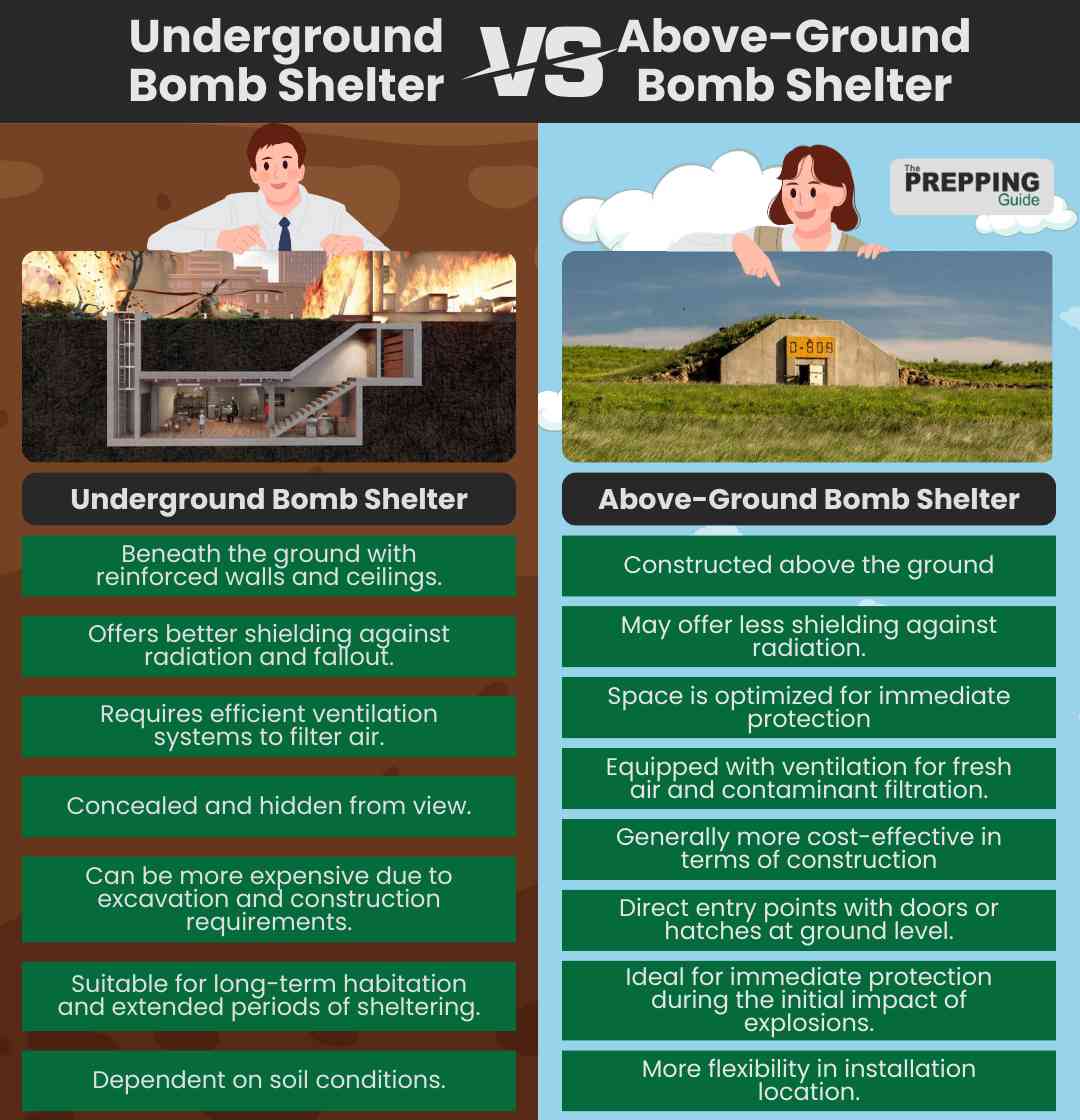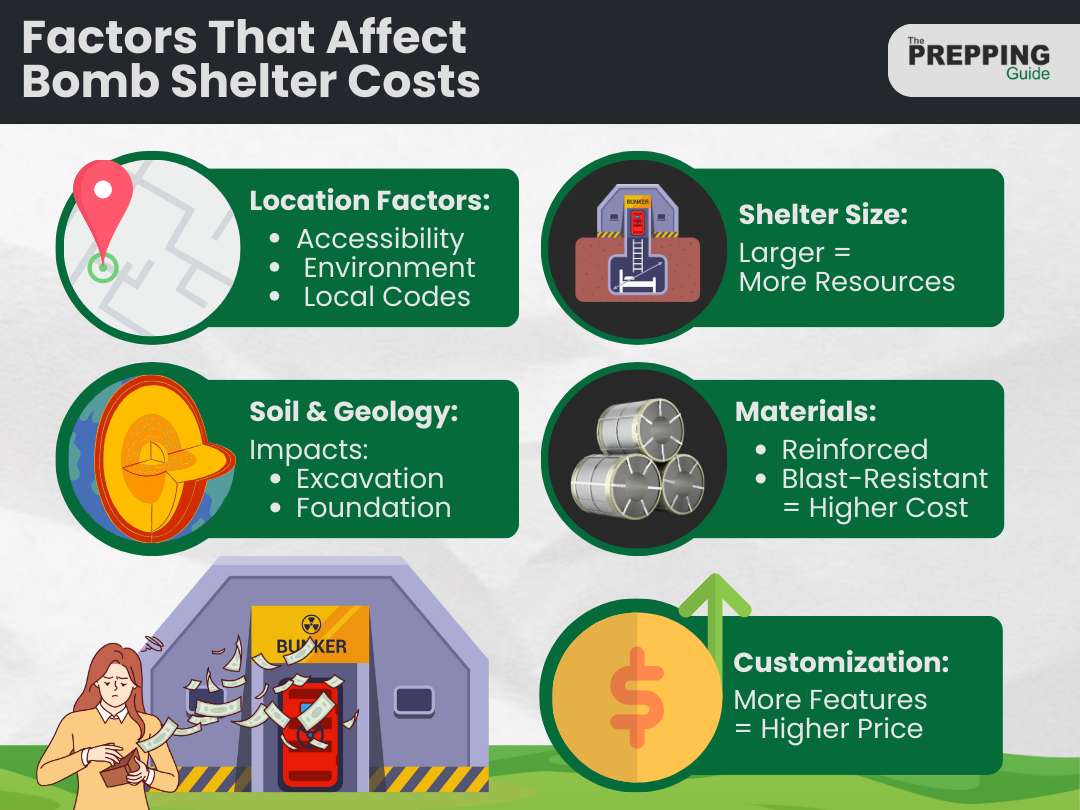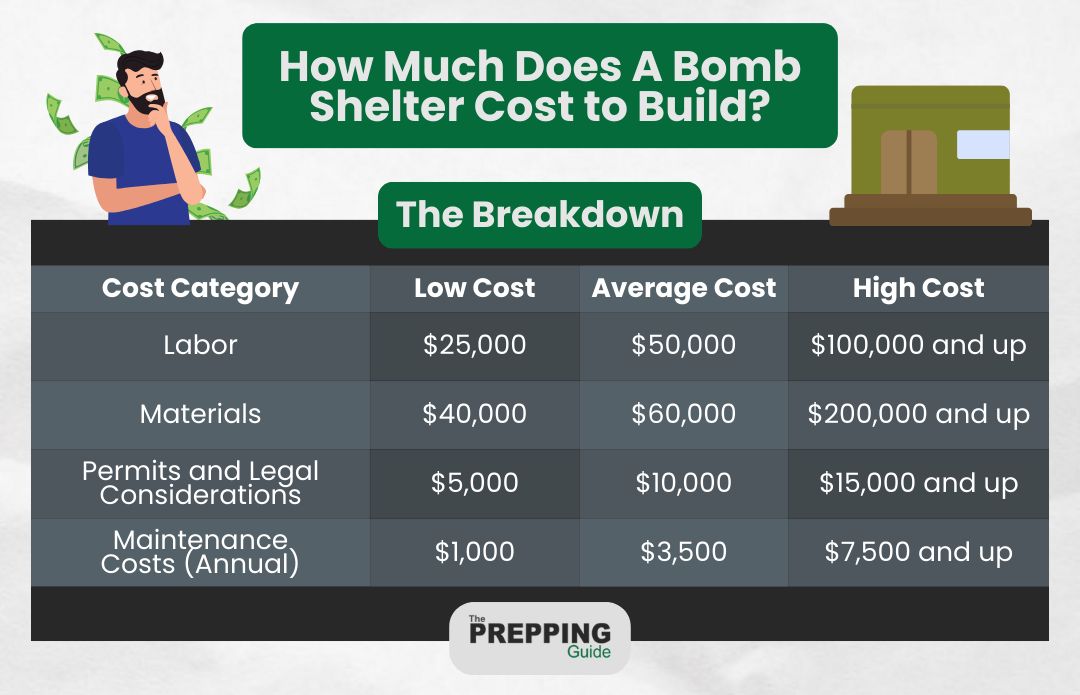A secure refuge is paramount for you and your family’s peace of mind and safety. The thought of a bomb shelter may conjure images of Hollywood movies, but in today’s unpredictable world, it is a practical consideration for many. If you are wondering how much does a bomb shelter cost to build, you’ve come to the right place.
The cost of building a bomb shelter can vary widely depending on size, materials, and location. On average, a basic underground bomb shelter can cost anywhere from $30,000 to $60,000, while more elaborate and customized options can exceed $100,000.
From exploring different types of shelters to understanding the factors that influence costs, we will delve into the intricate details of budgeting for your sanctuary. Whether you seek protection from natural disasters or man-made threats, knowing the ins and outs of bomb shelter costs can help you make an informed decision.
Types of Bomb Shelters To Consider
When considering bomb shelters, two main types to think about are underground bomb shelters and above-ground bomb shelters.

Underground Bomb Shelters
An underground bomb shelter is a protective structure designed to provide refuge and safety in the event of a chemical or nuclear attack. Typically constructed beneath the ground, these shelters aim to shield occupants from the destructive effects of explosions, radiation, and fallout. They can vary in size and complexity, ranging from basic, practical structures to more sophisticated and customized designs.
Underground bomb shelters often include reinforced walls and ceilings, ventilation systems, emergency supplies, and sometimes even living amenities to sustain occupants for an extended period. These shelters serve as a preparedness measure for individuals or communities, offering a secure space to seek refuge and increase the chances of survival during times of crisis.
While bomb shelters gained prominence during the Cold War, some individuals and organizations continue investing in them today as a precaution against potential security risks. The level of sophistication and cost can vary, allowing flexibility in meeting different needs and budgets for those seeking a secure haven in times of crisis.
Above-Ground Bomb Shelters
An above-ground bomb shelter, also known as a blast shelter or hardened above-ground structure, is a protective enclosure designed to shield individuals from the effects of explosions and potential fallout. Unlike traditional underground bomb shelters, these structures are constructed above the ground and often resemble reinforced concrete bunkers.
The primary purpose of an above-ground bomb shelter is to provide a secure space that can withstand the shock waves generated by a nuclear or conventional explosion, offering protection from collapsing structures and debris. These shelters typically feature thick walls and ceilings reinforced with materials like concrete or steel to enhance structural integrity and resist the impact of blast forces.
Above-ground bomb shelters are commonly used in military installations, government facilities, and critical infrastructure to safeguard personnel and equipment. The design considerations for these shelters include factors such as blast resistance, ventilation systems to filter out contaminants, and emergency supplies to sustain occupants during extended periods.
Factors Influencing Bomb Shelter Costs

In the factors influencing bomb shelter costs, you should consider your geographic location, soil and geological conditions, shelter size and capacity, construction materials, customization options, and additional features.
Geographic Location
In certain areas, bomb shelters can be costly due to varying construction regulations and material availability. The geographic location plays a significant role in determining the overall cost of building a bomb shelter.
Some regions may have stricter safety regulations that require more robust materials or specialized design options, ultimately driving up the expenses. Additionally, certain locations might have limited access to specific construction materials, making them more expensive to procure and transport.
It is essential to consider these factors when planning your budget for a bomb shelter project. By conducting a cost comparison based on your geographic location, you can better prepare for potential challenges and ensure that you stay within your financial means while prioritizing safety and compliance with local regulations.
Soil and Geological Conditions
Considering the geographic location of your bomb shelter is crucial, but equally important are the soil and geological conditions of the area. The soil composition plays a significant role in determining the structural integrity and depth of a bomb shelter.
Before construction begins, a thorough geological survey should be conducted to assess potential risks such as unstable ground or water tables. The excavation process will heavily depend on the type of soil present and any geological factors that may impact construction.
Proper drainage systems must also be implemented to prevent water accumulation around the shelter, which could compromise its stability over time. By understanding the soil composition and conducting a detailed geological survey, you can ensure that your bomb shelter is built with durability and safety in mind.
Shelter Size and Capacity
Regarding shelter size and capacity, focusing on the design that best suits your requirements is crucial. The cost breakdown will heavily depend on the size of the shelter, with larger shelters costing more due to materials and labor expenses.
Size considerations should factor in not just the number of people but also any supplies or equipment you plan to store. Capacity planning is essential for long-term use and potential emergencies.
Lastly, remember that construction timelines can vary based on the complexity of the design and any unforeseen challenges that may arise during building.
Construction Materials
When considering the construction of a bomb shelter, the size and capacity play a crucial role in determining its effectiveness. However, equally important are the materials used in building it. The right construction materials can ensure the durability and safety of the shelter in times of crisis.
Shelter design must consider space requirements and the strength and resilience needed to withstand potential threats. The construction process should involve skilled professionals who understand working with materials that provide maximum protection.
Safety features such as reinforced walls, ceilings, and a reliable ventilation system are essential components of a well-built bomb shelter. Additionally, stocking emergency supplies ensures that you’re fully prepared for any situation that may arise.
Customization and Additional Features
Customization and additional features significantly impact the cost of building a bomb shelter. The level of customization, such as specific design preferences, size requirements, and architectural specifications, can lead to increased costs in both labor and materials.
Specialized features like advanced air filtration systems, reinforced blast-resistant materials, emergency power sources, and amenities for extended stays also contribute to higher expenses.
Moreover, the choice of location and the complexity of excavation can affect costs, as certain terrains may require more extensive groundwork. Including technology for communication, security systems, and advanced ventilation can add to the overall expense.
Breakdown of Bomb Shelter Costs
Breaking down bomb shelter costs, you will find that they primarily consist of labor, materials, permits, legal considerations, and maintenance costs.
Here’s a breakdown of bomb shelter costs categorized as low, average, and high:

These estimates provide a range for each category, with the low cost representing more basic or smaller-scale projects, the average cost reflecting standard considerations, and the high estimate accounting for larger or more complex bomb shelters with premium features.
Actual fees may vary based on specific project requirements, geographical factors, and individual preferences.
Labor
Labor costs are typically the largest expense when building a bomb shelter. Finding skilled workers who’ve received proper training is crucial to ensuring efficiency during the construction process. Time management and productivity play a significant role in controlling labor costs, as delays can lead to increased expenses.
Considering workforce availability and scheduling when planning labor costs is essential, as having the right number of workers at the right time can help streamline the building process. Cost control and budgeting are key aspects that need careful attention to avoid overspending on labor expenses.
By carefully managing these factors, you can ensure your bomb shelter is built efficiently while staying within budget constraints.
Materials
Materials play a crucial role in ensuring your underground refuge’s structural integrity and safety. It’s essential to consider various factors such as building regulations, construction techniques, shelter design, safety measures, and cost estimates.
Selecting high-quality materials is key to creating a durable and secure shelter that can withstand extreme conditions. Each component contributes to the overall strength and functionality of the shelter, from reinforced concrete for walls and ceilings to blast-resistant doors and ventilation systems.
Additionally, incorporating earthquake-resistant features and waterproofing materials can further enhance the resilience of your bomb shelter.
Some of the materials costs include:
- Reinforced Concrete – $10,000 – $30,000
- Blast-Resistant Materials – $15,000 – $40,000
- Ventilation Systems – $5,000 – $15,000
- Emergency Supplies (Initial Setup) – $7,000 – $20,000
- Electrical and Wiring – $3,000 – $10,000
- Plumbing – $3,000 – $10,000
Permits and Legal Considerations
Permits and legal considerations play a crucial role in the construction of underground shelters. Obtaining the necessary permits can reduce the risk of fines and legal issues during the building process.
Before starting construction, it’s essential to research permit requirements specific to bomb shelters in your area. Legal restrictions may dictate where you can build your shelter and what materials you can use. Understanding these regulations can help you avoid costly delays or even having to tear down your structure.
Additionally, consider the construction timeline when applying for permits, as some approvals may take longer than others. Budget considerations should also include permit fees, which vary depending on location, and ensure compliance with zoning regulations to prevent future issues with authorities.
Maintenance Costs
The maintenance costs of building a bomb shelter primarily depend on the materials used, the complexity of the shelter’s design, and the frequency of inspections and upkeep. Regular inspections are crucial to ensure that the shelter remains structurally sound and that all integrated systems, such as ventilation and filtration, function correctly.
Maintenance costs may include replacing worn-out components, routine structural assessments, and updating technologies to meet current safety standards. Additionally, weather conditions and geographical location can impact maintenance needs, as exposure to extreme temperatures, moisture, or seismic activity may accelerate wear and tear.
Regularly updating emergency supplies, such as food, water, and medical provisions, is also part of the ongoing maintenance to guarantee the shelter’s readiness for extended periods of use.
Average Bomb Shelter Cost (Total)

If you want a tool to assist you in planning your finances to build your own shelter, consider using this shelter cost estimate calculator.
How About Custom-Built Bomb Shelters?
Custom-built bomb shelters represent a tailored approach to personal safety and preparedness, allowing individuals to design a shelter that meets their needs and preferences. From underground chambers equipped with state-of-the-art ventilation systems to above-ground structures designed for immediate accessibility, custom-built bomb shelters offer diverse choices.
While the cost of custom-built bomb shelters may be slightly higher than standard or DIY options, the investment provides peace of mind and a sense of control in the face of potential threats. Many custom companies offer clients the ability to create a secure space uniquely suited to their needs and preferences.
As the demand for personalized safety solutions continues to rise, custom-built bomb shelters pave the way for a new era in preparedness, where individuals can actively shape their protective environments.
Rising Bunkers is an example company in this niche, known for constructing bespoke bomb shelters. These shelters go beyond the standard offerings, allowing clients to choose the size, features, and level of customization that align with their unique requirements.
To give you an idea of their current custom-built bomb shelter prices, refer below:
- Standard Bomb Shelter 10 x 20 Base – $72,900
- Standard Bomb Shelter 10 x 20 Upgrade – $78,900
- Standard Bomb Shelter 10 x 30 Base – $90,900
- Standard Bomb Shelter 10 x 30 Upgrade – $97,900
- Standard Bomb Shelter 10 x 40 Base – $103,900
- Standard Bomb Shelter 10 x 40 Upgrade – $114,900
Funding Options
Securing funding such as government grants and assistance programs can help families ensure their safety and peace of mind in times of crisis. When building a bomb shelter, financial assistance is available through various government subsidies and funding options.
Eligibility criteria for these programs often depend on factors such as income level, location, and the family’s specific needs. To apply for these grants, families may need to go through an application process that involves providing detailed information about their situation and reasons for needing assistance.
In connection, FEMA (Federal Emergency Management Agency) provides grant funding through its Hazard Mitigation Assistance (HMA) programs to support the construction or installation of safe rooms.
In the context of FEMA funding, safe rooms are specifically designed to provide near-absolute protection for individuals during tornadoes and other high-wind events. To qualify for funding, these safe rooms must meet FEMA’s criteria and design standards.
It’s important to note that FEMA’s programs and funding availability may evolve, and specific details can change. For the most current and detailed information on FEMA’s safe room funding, it is advisable to check FEMA’s official website or contact FEMA directly for the latest updates and program guidelines.
Challenges and Considerations
When thinking about creating a bomb shelter, several challenges and factors must be considered. Budget planning is crucial, as building a bomb shelter can be expensive depending on your chosen size, materials, and features. It’s important to carefully assess your financial resources and prioritize non-negotiable aspects for your shelter.
Design considerations play a significant role in the construction of a bomb shelter. You must consider location, ventilation systems, structural integrity, and ease of access. These design elements will impact your shelter’s overall functionality and effectiveness during an emergency.
Safety regulations must also be adhered to when building a bomb shelter. Ensure you comply with local building codes and regulations to guarantee your and your family’s safety.
Additionally, stocking up on emergency supplies and ensuring family preparedness is essential to creating a reliable bomb shelter. Make sure you have enough food, water, medical supplies, communication devices, and other necessities to sustain yourselves in case of an emergency. Planning ahead is key to effectively facing any challenges that may arise during times of crisis.
Cost-Saving Strategies
If you’re looking to save costs on building a bomb shelter, consider the option of DIY construction versus hiring professionals. By taking on some of the work yourself, you can cut down on labor expenses and have more control over the final outcome.
DIY vs. Professional Construction
When deciding between DIY construction and professional help, there are several factors to consider. If you have budget constraints, opting for a DIY approach may seem more cost-effective initially. However, keep in mind that professionals have the expertise to work efficiently within your budget.
Additionally, considering the construction timeline, DIY projects may take longer due to a lack of experience and resources. Safety concerns should also be taken into account, as bomb shelters require proper reinforcement and ventilation systems to protect against potential threats.
Building regulations must also be adhered to ensure the structure meets safety standards and legal requirements. Ultimately, weighing these factors will help determine whether DIY or professional construction is the best choice for your bomb shelter project.
If you plan to go DIY, take a look at this $30,000 bomb shelter featured in Fox News Utah for reference.
Optimizing Size and Features
If you’re considering whether to opt for a DIY bomb shelter or hire professionals, it’s crucial to think about optimizing the size and features of your shelter. This step is key in ensuring cost-effectiveness while maximizing the benefits of your investment.
When customizing features, prioritize budget-friendly options that enhance functionality without compromising safety. Efficiently utilizing space can significantly impact affordability, making sure every inch serves a purpose without unnecessary expense.
Designing with price considerations in mind will help manage costs while still achieving an efficient layout. By enhancing functionality while managing expenses, you can create a bomb shelter that meets your needs without breaking the bank.
Alternative Materials and Methods
You can explore innovative options to enhance your shelter’s durability and functionality when considering alternative materials and methods. Eco-friendly alternatives, such as recycled materials or sustainable construction techniques, can not only reduce the environmental impact of your bomb shelter but also provide long-lasting protection.
Budget-friendly options, like repurposed shipping containers or earthbag construction, can help keep costs down without sacrificing safety. Innovative designs incorporating underground structures or modular components can maximize space efficiency while maintaining structural integrity.
DIY techniques offer a hands-on approach for those looking to customize their shelter design while saving on construction expenses.
The True Cost of Security
In conclusion, building a bomb shelter can be a costly but crucial investment in preparedness. By carefully considering the types of shelters available, factors influencing costs, and funding options, you can make an informed decision that suits your needs and budget.
Remember, ‘you get what you pay for,’ so prioritize quality and safety when planning your shelter. With strategic cost-saving strategies in place, you can build a secure bomb shelter without breaking the bank.
